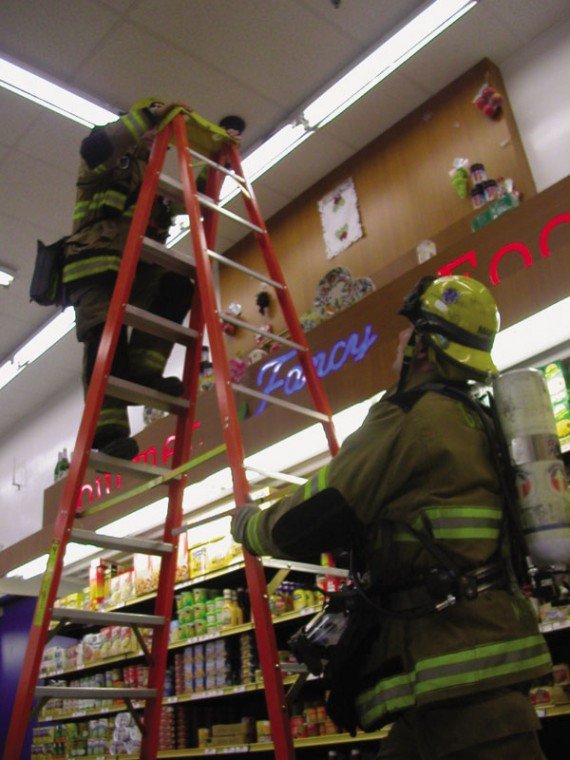When firefighters respond to a 911 call, they must remain
focused, precise and diligent
It seems to happen almost simultaneously: The alarm rings, dispatchers’ voices come over the radio and firefighters are on their feet, headed for the door.
From the moment they are dispatched to the 911 call, firefighters move in harmony, as if they’re part of a perfectly choreographed dance. There is no panic, only a distinct sense of urgency.
Details of a reported structure fire echo through the station, and the firefighters listen as they move. They pull on their boots and “turn out” pants that make up the bottom half of their heavy yellow protective fire gear. They take their places on the fire engine and it pulls out of the garage, sirens wailing and red lights flashing.
This is just one of the many kinds of 911 calls South Valley firefighters respond to every day. When a call comes into the station, firefighters have 60 seconds to be on the engine and responding to the call. At night, during sleeping hours, they have 120 seconds.
In addition to fires, crews also respond to medical calls with AMR, the ambulance company operating in Gilroy.
“We try to treat every call like ‘what if this was my family?'” said firefighter paramedic Heinz Maibaum. “We take every call we go to really seriously.”
Such a sense of importance is evident in this call. Engineer Lani Antonio is listening to the location of the reported structure-fire call, carefully driving through stop signs and intersections. He expertly guides the truck to the local discount store where the call was made.
The captain, Joshua Valverde, is in the passenger seat and on the radio, talking with dispatch, trying to get a solid mental picture of what they will face once on scene.
In the back of the engine, firefighters Michael Pardini and Maibaum put their turn out jackets on, followed by their air supplies and helmets.
Half way to the scene, dispatchers tell Valverde it’s now unclear if there is really a fire or if it’s just the smell of a possible gas leak.
As the crew arrives at the store, Valverde describes the scene on the radio to the dispatchers. There are no visible signs of smoke, and customers are still inside the store. He tells the dispatchers to cancel the county fire truck that is on the way and to tell the other engines responding they don’t need to use lights and sirens.
Valverde, Pardini and Maibaum jump out of the engine as soon as it stops, and Antonio goes to the side of the truck. He prepares to initiate the flow of water from the truck’s internal tanks if, indeed, there is a fire.
The firefighters do a quick sweep of the store, searching for signs of fire, as Valverde talks with the store manager to determine the exact problem.
She takes him to a back corner of the store, explaining that customers and an employee have complained of a gas smell, and two people reported seeing some sort of white smoke.
As she speaks, the firefighters begin pawing through the shelves of food to look for signs of smoke behind the boxes and jars of goods. They smell different packages, checking to see if any of the products’ scents could be mistaken for gas. The fluorescent lights overhead are examined to make sure one of them hasn’t blown out, which can often create a brief appearance of a white, smoke-like powder in the air.
All the while, Valverde is talking with the manager and communicating with dispatch.
“I canceled all the other fire engines heading over here, and I told the division fire chief there is no fire,” he says. “We’re still not sure what’s causing the smell, but whatever it is doesn’t require three fire engines and the chief responding to it.”
Pardini whips out a device resembling an over-sized speed radar gun that thermally displays the temperature of the walls and behind large items, such as stacks of boxes, that are in the firefighters’ way.
“If there was a fire in the walls or a hot spot anywhere, I could see it on this screen,” he explains.
Pardini points the device at walls, the ceiling and stacks of boxes in the store’s stock room. Everything appears a cool blue-ish color on the thermal readings. Maibaum crosses the path where the device is pointing, and his body heat shows up as a bright human-shaped flash of white light on the screen.
As the firefighters search, customers stare and whisper to each other about what’s going on. One customer, a boy about 6 years old, stares in awe at these big men in uniform. Maibaum stops, leans down and says hello. The two have a brief conversation, with Maibaum doing most of the talking and the boy doing most of the gaping.
While Valverde communicates with the people involved with the call, he asks the firefighters to get a ladder so they can remove a ceiling panel in search of any potential fire source hidden in the rafters.
After a thorough investigation, the men find no sign of fire, no source of smoke and no place from which gas could be leaking. As the men start to leave, Valverde reminds the store manager not to hesitate to call them back if she thinks its necessary. They climb back into the truck and head to the station.
Remember: RECEO
Firefighters think RECEO when responding to a call. It stands for:
R for rescue
Firefighters need to know if there is someone in a burning building or in a car that’s been involved in an accident.
E for exposure
If a house has burned past the point of saving it, firefighters must turn their attention to neighboring houses that may be threatened by the flames. Also, if one room in a house has burned past saving, focus is turned to the rest of the house, now exposed to danger.
C for confine
Keeping the fire restricted to a small area and preventing it from growing or spreading is important to put it out quickly.
E for extinguish
Some people think putting out a fire is as simple as throwing water on it, but that’s not the case. You have to assess the proceeding steps before getting to the water part of responding to a fire.
O for overhaul
Cleaning up after a fire is another one of firefighters’ duties.














